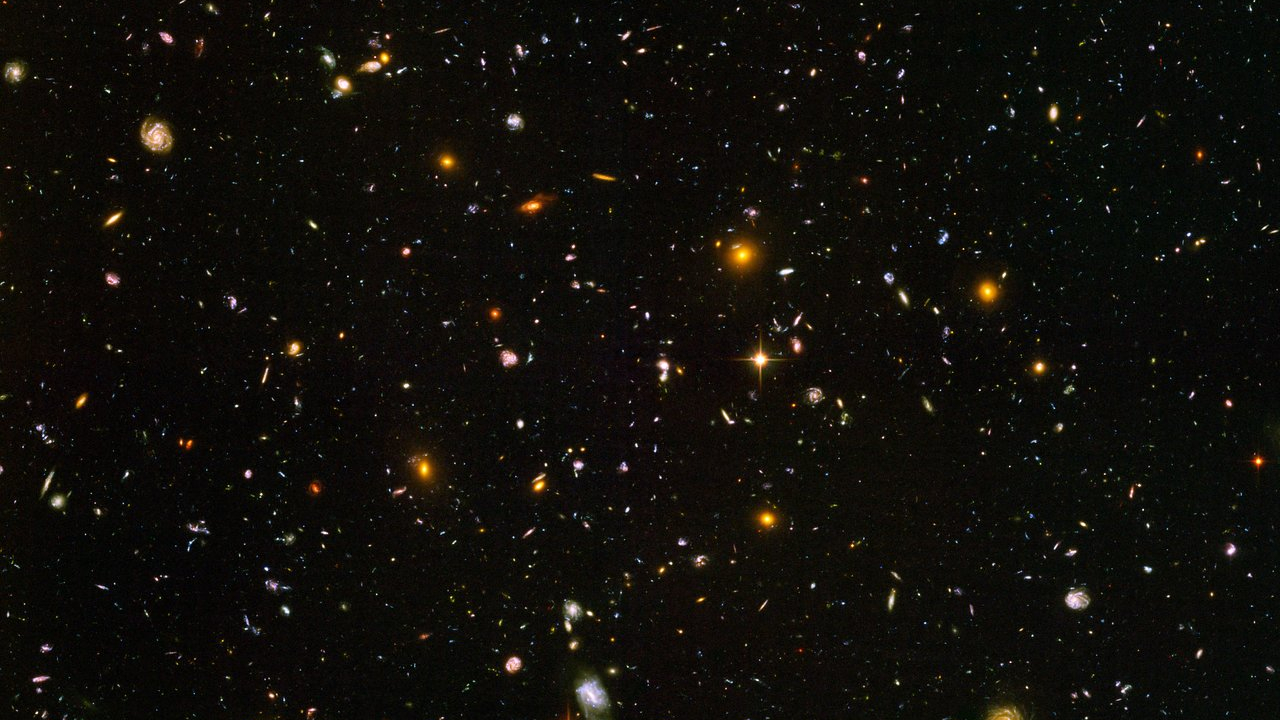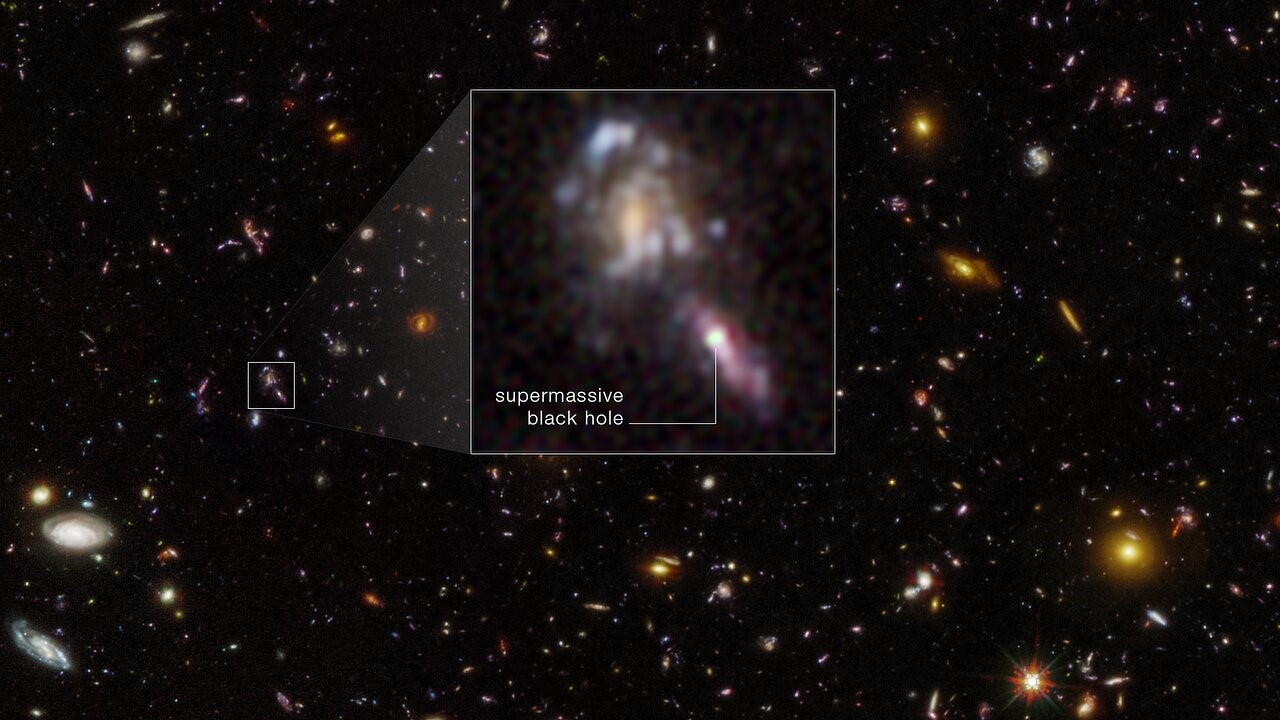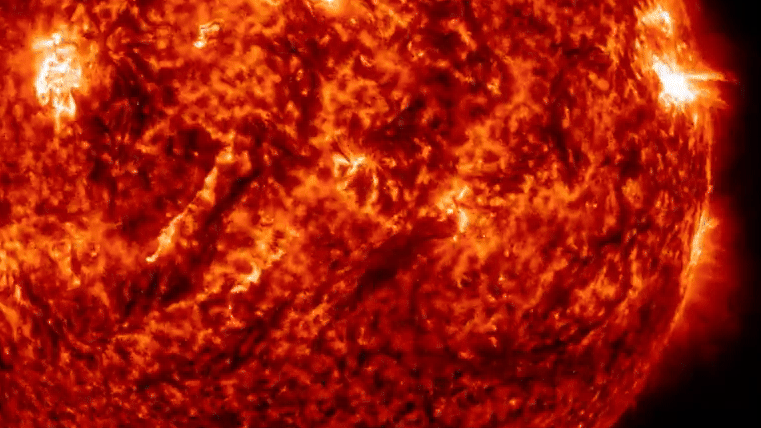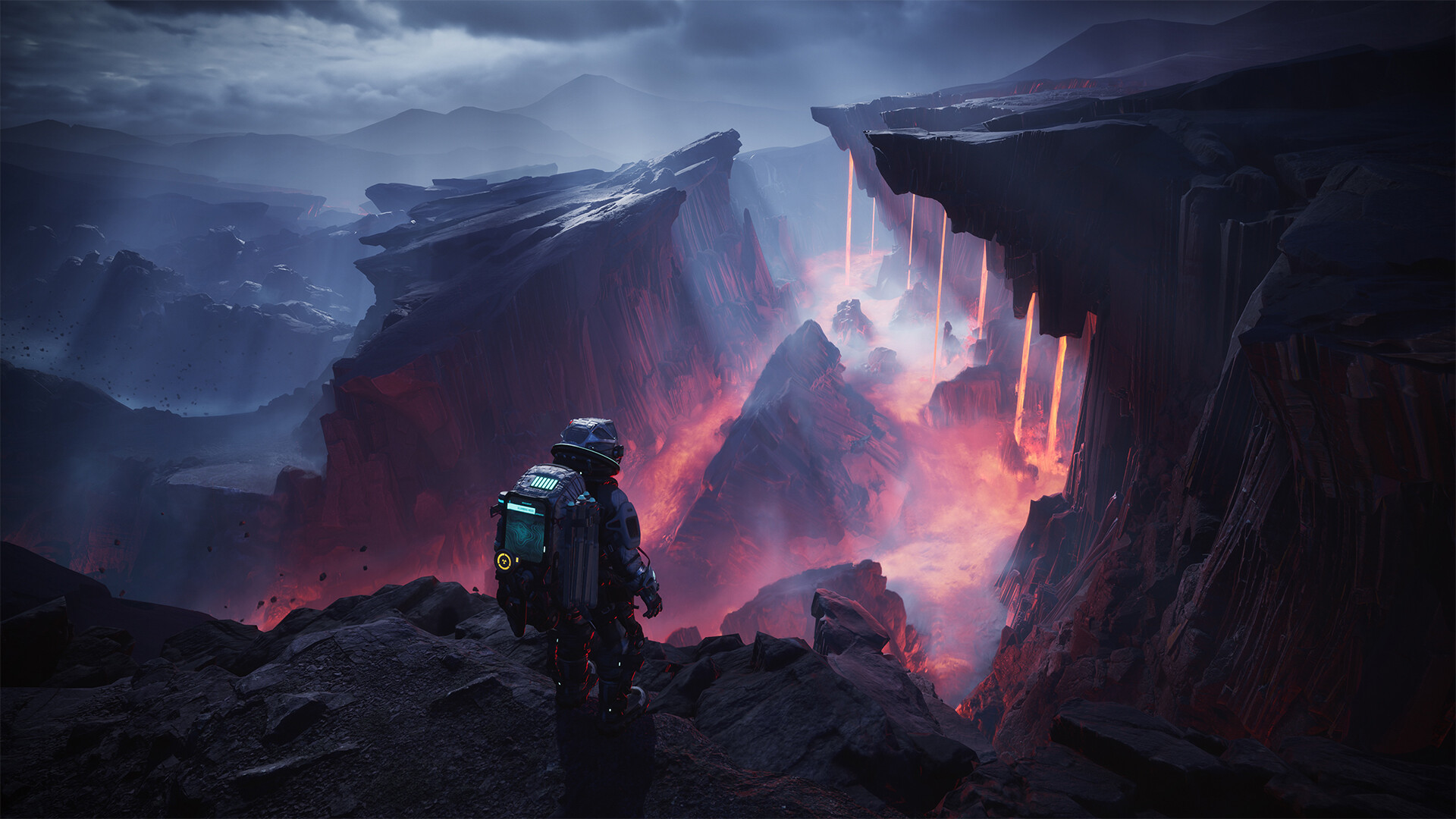Hubble Space Telescope suggests our ancient universe was surprisingly crowded with supermassive black holes
Three active galactic nuclei from the early universe were found in just a small patch of sky. How many more could there have been?

A host of supermassive black holes populating the universe during the cosmic dark ages appears to drastically exceed estimates for how many billion-solar-mass black holes should have existed back then. The surprising find is the result of a 14-year study conducted with the Hubble Space Telescope.
The study team, led by Matthew Hayes of Stockholm University, searched for these early supermassive black holes by scouring the Hubble Ultra Deep Field for any faint objects that seem to exhibit variable brightness.
The Hubble Ultra Deep Field offers an extremely deep look into a tiny patch of the night sky — 3.1 square arcminutes, to be precise. It contains about 10,000 galaxies from all different epochs of cosmic history, with the faintest existing when the universe was less than 500 million years old.
Hayes' group studied a small sample of the Hubble Ultra Deep Field, looking for anything that might have changed brightness over time. The reasoning behind this criteria is that supermassive black holes should have grown very quickly to become so massive in less than a billion years after the Big Bang — and to grow so rapidly, they should have been feeding rapidly on the matter that forms intensely hot and luminous accretion disks around black hole. Astronomers more specifically call these objects AGN, or active galactic nuclei, and they can significantly outshine the rest of their host galaxy.
However, the infall rate of matter onto an AGN is not constant. Like a river, the flow can sometimes surge, and other times drop to a trickle. In turn, this can affect the brightness of an AGN. So, Hayes' team searched the Hubble Ultra Deep Field for anything that changed brightness because that variation could indicate an AGN.
In their small search area, the researchers found 71 variable sources. Many of these are seen as they were when the universe was only several billion years old. Some of the selected subjects are associated with supernova explosions in a galaxy in the field of view, but three of the sources indeed appear to be AGN that existed over 12.7 billion years ago, when the cosmos was less than a billion years old.
Given how small the observed patch of the night sky was, finding three AGN powerful enough to mark billion-solar-mass black holes in such an early epoch of time greatly exceeds expectations (for comparison, the supermassive black hole in our galaxy, Sagittarius A*, is only 4.1 million solar masses, and it has had over 13 billion years to grow to its size). Extrapolating across the entire sky also means reaching the conclusion that such enormous black holes must have been plentiful in this ancient epoch of the universe. And their enhanced numbers may provide strong clues about how they formed.
Get the Space.com Newsletter
Breaking space news, the latest updates on rocket launches, skywatching events and more!
"Many of these objects seem to be more massive than we originally thought they could be at such early times — either they formed very massive or they grew extremely quickly," said Stockholm' University's Alice Young, who is a member of Hayes' team, in a statement.

One of the faraway AGN, labeled 105212, brightened by 0.3 magnitudes between 2009 and 2012, but by 2023 it had faded by 0.17 magnitudes. It's measured to be at a redshift of 6.7, meaning that we see it as it existed around 12.8 billion years ago. Another AGN, designated 101159, is at a similar redshift of 6.5 and was visible in 2009 but had faded out of sight during the years 2012 and 2023. We know it is real though, because the James Webb Space Telescope (JWST) has since imaged the host galaxy that this AGN resides in. The third high-redshift AGN is 1052156, which is at redshift 6.2 and was seen to change brightness by 0.2 magnitudes between 2009 and 2012, and had faded out of sight by 2023.
There are many hypotheses about how supermassive black holes came to be in the early universe. Were they born in the immediate aftermath of the Big Bang from microscopic primordial seed black holes that have been growing ever since? Or did they get a kickstart in their growth by forming through the direct collapse of an immense gas cloud thousands of times more massive than our sun?
The number density of billion-solar-mass black holes in the early universe that Hayes' team uncovered actually best fits simulations that depict supermassive black holes growing from the collapse of the very first, extremely massive stars. These stars formed in huge "mini-haloes" of matter and dark matter in the cosmos and had masses thousands of times greater than our sun.
Rather than exploding as supernovas, however, these primordial stars quickly collapsed in on themselves from their own gravitational pulls, forming what are called intermediate mass black holes (more massive than the typical stellar mass black holes produced by supernova explosions today, yet less massive than the supermassive behemoths). These first stars formed perhaps between 150 million and 200 million years after the Big Bang, and quickly began consuming matter and growing.
The next generation of stars that formed would have been unable to form black holes of such huge masses, because their birth zones were irradiated by ultraviolet light from other nearby stars and buffeted by the shockwaves of nearby supernovas, which would have altered the conditions for star formation. The next generation of stars were more "normal" stars with masses typical of what we find in our galaxy today.
'"The formation mechanism of early black holes is an important part of the puzzle of galaxy evolution," said Hayes. "Together with models for how black holes grow, galaxy evolution calculations can now be placed on a more physically motivated footing, with an accurate scheme for how black holes came into existence from collapsing massive stars."
If correctly interpreted, the findings could therefore not just teach us about supermassive black holes, but also about the very first stars to exist. The next step is to probe even more carefully and more deeply into the universe with the JWST. However, having only launched in December of 2021, the JWST has not yet had a chance to build up observations over a long enough time frame to detect the variability of AGN in the early universe. The JWST imaged the Hubble Ultra Deep Field on its own for the first time in 2023 —- but, as Hayes' team writes in its research paper, the Hubble Space Telescope has provided a head start.
The findings were published on Aug. 6 in The Astrophysical Journal Letters.
Join our Space Forums to keep talking space on the latest missions, night sky and more! And if you have a news tip, correction or comment, let us know at: community@space.com.

Keith Cooper is a freelance science journalist and editor in the United Kingdom, and has a degree in physics and astrophysics from the University of Manchester. He's the author of "The Contact Paradox: Challenging Our Assumptions in the Search for Extraterrestrial Intelligence" (Bloomsbury Sigma, 2020) and has written articles on astronomy, space, physics and astrobiology for a multitude of magazines and websites.
-
Unclear Engineer So now the theory is that intermediate mass black holes essentially developed from the collapse of dense clouds of gas in the early universe, before there were stars and other black holes heating the gas. The article calls these collapsing areas the first stars, but I wonder if the collapses were slow enough for fusion to start and temporarily hold the collapsing gas back for a while, or if the gas just quickly developed an event horizon and the rest of he universe has no idea what goes on inside.Reply
Or, perhaps we just have not properly calculated the age of he universe, and the areas we can now see (very faintly) are much older than the theory supposes, so that these black holes really had much more time to develop. A theory that just turns on and off an unknown and unconstrained "dark energy" with the power to do whatever a theory needs to work could probably be developed to do all sorts of things with the timing billions of years ago. -
Fire-Starter James V(r) = HrV(r) = c \00d7 tanh(Hr/c)Reply
Infinity is real. So is Eternity.
Can we get somebody else to test this?
Or at least say what's wrong with it? -
Unclear Engineer So, you propose that the recession rate is limited to c, approaching it asymptotically as r goes to infinity. See graph in https://www.mathworks.com/help/matlab/ref/double.tanh.html .Reply
What is your basis for that proposal?
How does it fit with the current measurements of recession rate vs distance? -
Fire-Starter James Reply
Yes. Using relativistic math, the expansion rate appears to diminish with distance, and relative masses increase.Unclear Engineer said:So, you propose that the recession rate is limited to c, approaching it asymptotically as r goes to infinity. See graph in https://www.mathworks.com/help/matlab/ref/double.tanh.html .
What is your basis for that proposal?
How does it fit with the current measurements of recession rate vs distance? -
Atlan0001 No one is thinking straight here regarding the 'metaphysics' of 'Infinite MULTIVERSE Universe' cosmology! Approach a black hole, most particularly such a supermassive black hole (as viewed from such a distance), and you approach an accelerating vector expansion of space and time universe (u) . . . until you are inside one from another (Chaos's self-similar strong-gravitational interactive fractal zooms structure of universes (u)).Reply
The view (of a "spooky action at a distance") is loaded down with point -portal singularities that would accelerate in expansion of opening seeds. -
Fire-Starter James This relativistic infinite universe has an observed "red limit", an apparent distance within which the infinite universe is causally connected. This "limit" should look very much like an event horizon. Infinity projected to the inside of a sphere.Reply
An infinite number of black hole's contents also might be infinite. Looks like an infinite multi-verse to me. -
Torbjorn Larsson Replyour ancient universe was surprisingly crowded with supermassive black holes
The various results on this question has now been clarified by a work that agrees with this.
Observations confirm astronomers' expectation that early-Universe quasars formed in regions of space densely populated with companion galaxies. DECam's exceptionally wide field of view and special filters played a crucial role in reaching this conclusion, and the observations reveal why previous studies seeking to characterize the density of early-Universe quasar neighborhoods have yielded conflicting results.
https://www.sciencedaily.com/releases/2024/09/240923121346.htm -
Torbjorn Larsson Reply
No. This work suggests the supermassive black hole seeds arose from the collapse of the first generation extra massive stars.Unclear Engineer said:So now the theory is that intermediate mass black holes essentially developed from the collapse of dense clouds of gas in the early universe, before there were stars and other black holes heating the gas.
The light speed limit applies to particle velocities, not the expansion speed of space.Fire-Starter James said:Yes. Using relativistic math, the expansion rate appears to diminish with distance, and relative masses increase.
The work is not dependent on the cosmology but on star and galaxy formation.Atlan0001 said:No one is thinking straight here regarding the 'metaphysics' of 'Infinite MULTIVERSE Universe' cosmology! -
Unclear Engineer I guess that depends on what you call an "intermediate mass" black hole and how massive you think a "star" can be before it collapses without burning out its hydrogen, first.Reply
At least in theory, a gas cloud can become a black hole without becoming a star, first. What happens inside such a black hole after the event horizon is formed would not be known outside of the event horizon.
But, the original article did say
"There are many hypotheses about how supermassive black holes came to be in the early universe. Were they born in the immediate aftermath of the Big Bang from microscopic primordial seed black holes that have been growing ever since? Or did they get a kickstart in their growth by forming through the direct collapse of an immense gas cloud thousands of times more massive than our sun?"
and
"best fits simulations that depict supermassive black holes growing from the collapse of the very first, extremely massive stars."
with
"Rather than exploding as supernovas, however, these primordial stars quickly collapsed in on themselves from their own gravitational pulls, forming what are called intermediate mass black holes (more massive than the typical stellar mass black holes produced by supernova explosions today, yet less massive than the supermassive behemoths)."
The point was
"The next generation of stars that formed would have been unable to form black holes of such huge masses, because their birth zones were irradiated by ultraviolet light from other nearby stars and buffeted by the shockwaves of nearby supernovas, which would have altered the conditions for star formation. The next generation of stars were more "normal" stars with masses typical of what we find in our galaxy today."
So, basically what I originally said: It is postulated that there were not enough stars to prevent the first large gas cloud collapses that created intermediate mass black holes. Whether or not the postulated gigantic first stars actually emitted radiation that heated the gas to prevent future collapses before they disappeared into black holes seems to be an unaddressed issue in the article. The culprits in the article seem to be "other nearby stars and buffeted by the shockwaves of nearby supernovas", which would not be coming from those massive stars that did not supernova.
So, basically, it appears to mean that some of the first stars were big enough to collapse into intermediate mass black holes without going supernova, while other stars, also probably "first generation" but smaller, did last a while and change the star-forming environment with their emissions of UV light and shock waves. -
Unclear Engineer I think most scientists understand the meaning of "infinity".Reply
But, you don't seem to understand the need for "evidence".
Some people prefer the idea that everything has a beginning and an end, and are uncomfortable with the concept of something being infinite in extent, time or space.
Other people prefer the idea that the universe does not have to have a "cause" with a beginning and an end, and are more comfortable with the idea that something is never ending and always existed. They will want to know what happened "before" the universe existed and what it is expanding into if, as the BBT theorizes, it is finite in time and space, because they prefer to believe that time and space don't stop anywhere, past or future.
Some people are more comfortable with a "closed" finite and static universe, which is not infinite in space, but is in time.
NOBODY KNOWS WHICH, IF ANY OF THOSE CONCEPTS IS THE PHYSICAL TRUTH!!!
Even the BBT proponents have stopped trying to say what happened before the universe reached "Planck size" and what might be "outside" the radius of the matter they believe has expanded by tens of billions of light years since it exceeded the Planck size. They are just saying their theory does not address those questions - not that they know the answers.
You are free to believe what you like. But, you will need to produce convincing evidence if you want to make others believe what you believe.









